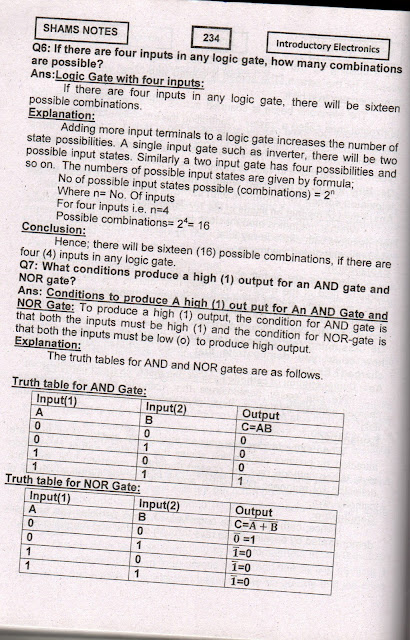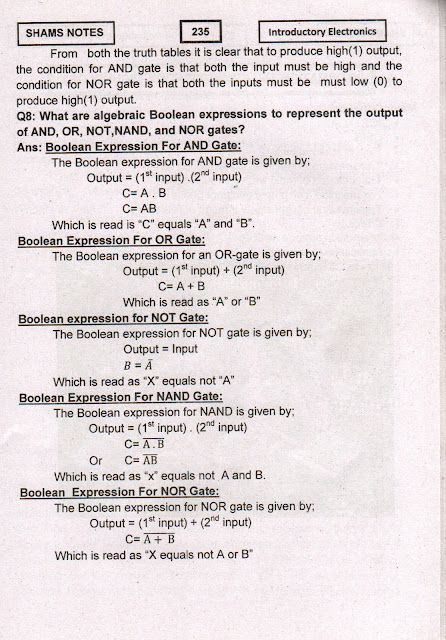Physics 10 Class Notes CHAPTER No 16 INTRODUCTORY ELECTRONICS
Physics Class X Notes comprehensive Question, Exercise, Conceptual Question & Numerical Problems pdf full notes.
Major Concepts
- Thermionic emission
- Properties of electrons
- Electron gun
- Cathode-ray oscilloscope
- Analogue and digital electronics
- Logic gates
comprehensive Question
Q1: Define electronics? Discuss the main branches of electronics? Electronics:
"The branch of applied physics which we deal with the study of electron-emitting devices, their use and control are called electronics. 'OR"
"The branch of physics which deals with the development of electron-emitting devices, their Utilization and controlling electrons flow in electrical circuits designed for various purposes is called electronics." Branch of Electronics:
Electronics can be divided into two main branches.
- Analogue Electronics. '
- Digital Electronics.
The branch of electronics which consisting of such circuits which processes analogue quantities is called analogue electronics.
Analogue Quantities:
The quantities whose values vary continuously (or) remain constant are called analogue quantities e.g the temperature of the air in the atmosphere is changing continuously during day and night. The public address sound system is another example of an analogue electronic system.
In this sound system, the microphone converts the sound of the speaker into electrical signals. The sound signal of the speaker is a variable (or) an analogue signal. The electrical signals sent out by the microphone are also analogue signals. The output of the microphone is fed into an amplifier, which is also an analogue instrument. The amplifier amplifies its input without changing its shape and operates a budding speaker. In this way is loud sound is produced out of the speaker.
Digital Electronics:
"The branch of electronics which deals with such circuits which provide data in the form of maximum and minimum voltage signals is known as digital electronics".
In this type of data, the change is not continuous and one part of the data is quite different from the other part of the data. The best example is that of the computer. Modern telephone system, radar system, medical. Equipment’s and my household appliances make use of digital electronics.
ADC and DAC
The things signals that we perceive by our five senses in our daily life are usually analogue quantities, which cannot be processed by digital circuits. To resolve this difficulty, a circuit has to be designed which can convert the analogue signals which can convert the analogue signals into digital signals. This is known as analogue to digital converter i.e. ADC.
When we analogue signals in the form of digital signals then we process it with the digital circuit, the output of which is also in digital form. The digital output is converted into analogue form by a circuit known is digital to analogue converter (DAC). As the output of DAC is an analogue signal, we can easily sense it. The electronic system used at present consists of both analogue and digital type circuits.
Q2: What is meant by thermionic Emission?
Ans: Thermionic Emission:-
"The phenomena of emission of electrons from heated metals is called thermionic emission." "OR"
"The emission of electrons from certain metals due to hat is known as thermionic emission."
Explanation:-
Thermionic emission can be produced by electrically heating a fine tungsten filament. This can be achieved by passing a current through the filament as shown in the figure.
Thermionic Emission by filament
Thermionic emission has -provided physicists with an important means of producing a continuous supply of electrons. In metals, the valance electrons are free to move like the atoms and molecules of gas which are free to move in the container. These electrons can move freely Through the metal and perform the random motion. Such electrons are known as free electrons. Now if we supply heat to the metal, then the valance electrons absorb the supplied heat energy and they become able to overcome the attractive forces of atomic nuclei. In this way, the electrons can escape from the surface of the metal. Such emission of electrons due to heat is known as thermionic emission.
Q3: Describe the construction and working of electron gun?
Electron Gun:
A device which is used to study the properties of the electron beam is called an electron gun.
Explnation.-
Electron gun consists of a glass tube in which the tungsten filament (cathode) and cylindrical anode are sealed at low pressure. The electrons are produced by thermionic emission from tungsten filament heated by a 6V supply. The electrons will be accelerated to high speed and they shoot straight through the hole of the anode in a fine beam of electrons. This electron beam is also called cathode rays as they are produced from the cathode (or) negative electrode.
Electron Gun
The effect of the electric field and magnetic field upon the beam of these free electrons is as follows.
a) Effect of electric field on Beam of electrons:-
When an electron beam passes between two plates, the electron beam deflect toward the positive plate as shown in the figure.
Physics 10 Class Notes CHAPTER No 16 Images Full Notes
PDF FULL NOTES CHAPTER NO 16 Physics 10 Class
Tags:
Physics 10
















